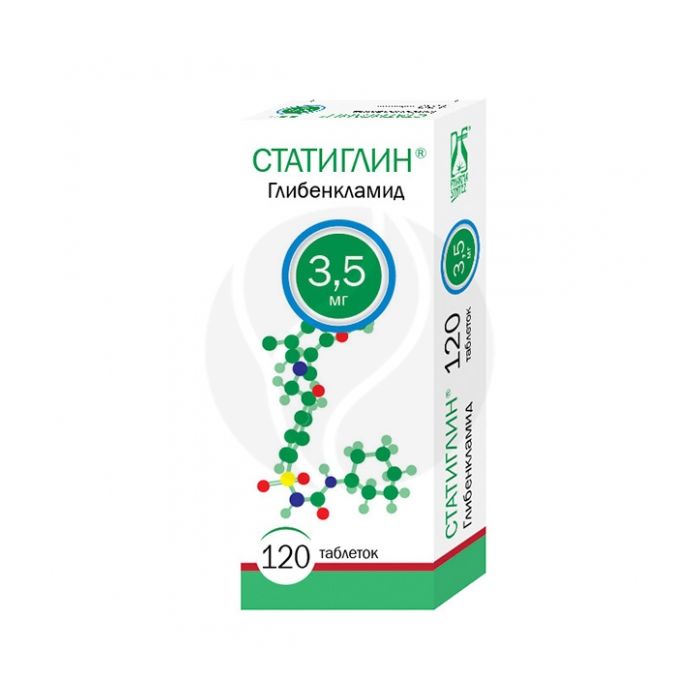Statiglin tablets 3.5mg, No. 120
Russian Pharmacy name:
Статиглин таблетки 3,5мг, №120
The dose is set individually, depending on the age, the severity of diabetes, the level of fasting blood glucose and 2 hours after meals.
The average dose is 2.5-15 mg / day, the frequency of administration is 1-3 times / day. Take 20-30 minutes before meals. In doses more than 15 mg / day, it is used in rare cases and does not cause a significant increase in the hypoglycemic effect.
For elderly patients, the starting dose is 1 mg / day. When switching from biguanides, the initial dose of glibenclamide is 2.5 mg / day.
Biguanides should be canceled, and the dose of glibenclamide, if necessary, can be increased by 2.5 mg every 5-6 days until the disturbances in carbohydrate metabolism are compensated.
In the absence of compensation within 4-6 weeks, it is necessary to plan a combination therapy with glibenclamide and biguanides.
Tablets are white or white with a yellowish tinge, round, flat-cylindrical, with a chamfer.
1 tab.
glibenclamide 3.5 mg
Excipients: lactose monohydrate - 93 mg, povidone K30 - 3.5 mg, low-substituted hyprolose - 23 mg, microcrystalline cellulose - 47 mg, sodium carboxymethyl starch - 8 mg, colloidal silicon dioxide - 1 mg, sodium stearyl fumarate - 1 mg.
Type 1 diabetes mellitus, ketoacidosis, diabetic precoma and coma, severe microcirculation disorders, infectious diseases, severe renal and / or liver dysfunction.
Hypersensitivity to sulfonylurea derivatives and sulfa drugs.
Not used for major surgical interventions.
pharmachologic effect
Oral hypoglycemic agent, sulfonylurea derivative of the second generation. Stimulates insulin secretion by? -Cells of the pancreas, increases insulin release. Acts mainly during the second stage of insulin secretion. Increases the sensitivity of peripheral tissues to insulin and the degree of its binding to target cells. It has a hypolipidemic effect, reduces the thrombogenic properties of blood.
Pharmacokinetics
After oral administration, glibenclamide is rapidly and almost completely absorbed from the gastrointestinal tract. Plasma protein binding is more than 95%. It is metabolized in the liver with the formation of inactive metabolites. It is excreted from the body mainly in the form of metabolites in the urine - 95% and in the bile. T1 / 2 - about 10 hours
Side effect
From the endocrine system: hypoglycemia up to coma (the likelihood of its development increases with a violation of the dosage regimen and an inadequate diet). Allergic reactions: skin rash, itching. From the digestive system: nausea, diarrhea, a feeling of heaviness in the epigastric region; rarely - liver dysfunction, cholestasis. From the side of the central nervous system and peripheral nervous system: rarely - paresis, sensitivity disorders, headache, fatigue, weakness, dizziness. On the part of the hematopoietic system: rarely - hematopoietic disorders up to the development of pancytopenia. Dermatological reactions: rarely - photosensitization.
Application during pregnancy and lactation
Glibenclamide is not recommended for use during pregnancy and lactation.
Application for violations of liver function
Contraindicated in severe liver dysfunction. Use with caution in patients with liver pathology (including history).
Application for impaired renal function
Contraindicated in severe renal impairment. Use with caution in patients with renal pathology (including a history).
Use in elderly patients
For elderly patients, the starting dose is 1 mg / day.
special instructions
It is used with caution in patients with liver and kidney pathology (including history), as well as in febrile conditions, dysfunction of the adrenal glands, thyroid gland, and chronic alcoholism. During therapy, regular monitoring of blood glucose and daily excretion of glucose in the urine is necessary. With the development of hypoglycemia, if the patient is conscious, glucose (or sugar solution) is administered orally. In case of loss of consciousness, glucose is administered intravenously or glucagon s / c, intramuscularly or intravenously. After the restoration of consciousness, it is necessary to give the patient food rich in carbohydrates in order to avoid the re-development of hypoglycemia. Patients taking glibenclamide should refrain from drinking alcohol. In the case of alcohol consumption, disulfiram-like reactions may develop, as well as severe hypoglycemia.
Drug interactions
An increase in the hypoglycemic effect of glibenclamide is possible with the simultaneous use of beta-blockers, anabolic agents, allopurinol, cimetidine, clofibrate, cyclophosphamide, isobarine, MAO inhibitors, long-acting sulfonamides, salicylates, chloramphenicol, tetracyclines, ethanes. The weakening of the action of glibenclamide and the development of hyperglycemia is possible with the simultaneous use of barbiturates, chlorpromazine, phenothiazines, phenytoin, diazoxide, acetazolamide, glucocorticoids, sympathomimetic agents, glucagon, indomethacin, high doses of nicotinates, contraceptives, oral hormones and estrogen hormones , high doses of laxatives.

